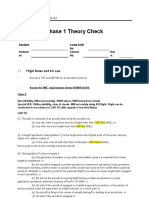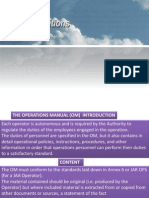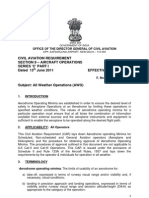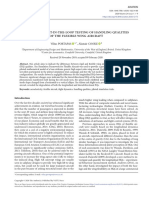(E.K. Bharat Bhushan) : AIC SL. No. 06/2011
(E.K. Bharat Bhushan) : AIC SL. No. 06/2011
Uploaded by
pawan737ngCopyright:
Available Formats
(E.K. Bharat Bhushan) : AIC SL. No. 06/2011
(E.K. Bharat Bhushan) : AIC SL. No. 06/2011
Uploaded by
pawan737ngOriginal Description:
Original Title
Copyright
Available Formats
Share this document
Did you find this document useful?
Is this content inappropriate?
Copyright:
Available Formats
(E.K. Bharat Bhushan) : AIC SL. No. 06/2011
(E.K. Bharat Bhushan) : AIC SL. No. 06/2011
Uploaded by
pawan737ngCopyright:
Available Formats
Telephone No. 24622495 Telegraphic Address: Commercial : AIRCIVIL NEW DELHI Aeronautical: VIDDYAYX E-Mail: dri@dgca.nic.
in Fax : 01124629221
GOVERNMENT OF INDIA AERONAUTICAL INFORMATION SERVICES
DIRECTOR GENERAL OF CIVIL AVIATION
AIC SL. No. 06/2011 2nd May 2011
OPPOSITE SAFDARJUNG AIRPORT NEW DELHI- 110 003.
File No.AV22029/54/99-FID File No.3/1/2007-AIS The following A.I.C. is issued for information, guidance and compliance by all concerned. This AIC supersedes AIC 9 of 2007
(E.K. Bharat Bhushan) Director General of Civil Aviation ---------------------------------------------------------------------------------------------------SUPERVISED TAKE OFF AND LANDING IN PUBLIC TRANSPORT OPERATIONS In order to afford co-pilots opportunity to acquire vital experience in handling the aircraft during critical phases of landing and take off, the following procedure shall be followed: The Pilot-in-Command who is solely vested with the responsibility of the safety of aircraft and passengers therein, may, authorise a Co-pilot of his flight to effect landing and take-off and route flying, under his direct supervision in accordance with the following conditions:-
1) The Pilot-in-Command who authorises such operation by Co-pilot shall be either, a DGCA approved Check Pilot/Instructor/Examiner or a pilot with a minimum of 1000 hours Pilot-in-Command experience including 500 hours on type who has an accident and incident free record in the preceding three years. The operator should make a selection of such pilots to assess their suitability for giving supervised take offs and landings.
2) Operators shall maintain up-to-date list of Pilots and Co-pilots who are authorised to give and receive supervised take-off and landing under intimation to DGCA.
3) The pilot who authorises such flight shall have at least 10 hours as Pilotin- Command experience on type during the preceding 30 days.
4) Examiners and Instructors may authorise a Co-pilot having a minimum of 50 hours flying experience as Co-pilot on type, to effect landing and take off under their supervision. However, an Examiner/Instructor while carrying out the Route Check of a Co-pilot having less than 50 hours experience may permit the Co-pilot to effect take off and landing required for the purpose of the check subject to fulfilling the conditions laid down in this Circular. 5) Pilots, other than the Examiners and Instructors who are authorised to give supervised take off and landing to Co-pilots mentioned in Para (1) above, may authorise Co-pilots having a minimum of 50 hours and 20 landings (both inclusive) experience on type after first officer final release check. The Co-Pilot experience shall be counted after the Co-Pilot has undergone First Officer final release check in accordance with Operations Circular 4 of 2007. 6) The operator shall lay down the detailed procedure consistent with this circular for effecting supervised take off and landing for their operating crew and ensure that the Pilots-in-Command specified in Para (1) above who are authorised to supervise take off and landing by Co-pilots are briefed about the procedure. 7) The Pilot-in-Command before authorising landing and take off under his/her supervision shall ensure that the aircraft is fully serviceable and due consideration shall be given to factors such as snags carried forward under minimum equipment list, serviceability of navigation and landing aids and runway conditions etc. The Reverse Thrust or appropriate system as installed, if applicable, must be serviceable.
8) While effecting supervised take off and landing, the Pilot-in-Command and the Co-pilot shall occupy the left hand and the right hand seat in the cockpit respectively. However, for routine LR/IR/Route Checks, the existing procedure shall continue; 9) Adequate pre-landing and pre-take off briefing shall be given by the Pilot-in-Command to the Co-pilot before authorising such operations. 10) For take off, the responsibility for thrust levers/ throttles shall be with the Pilot-in-Command and the decision and the execution of Reject Take Off (RTO) shall be the sole and complete responsibility of the Pilot-inCommand. Similarly, the decision and the execution of missed approach shall be the responsibility of Pilot-in-Command. In both these manoeuvres, the Pilot-in-Command shall clearly announce, I have the controls and take over the controls without compromising flight path/safety.
11) Supervised take off and landing shall not be permitted during an emergency/precautionary landing and CAT II or III operations, LVTO or any time PIC feels conditions are marginal. 12) The Pilot-in-Command shall ensure that during approach to land for an supervised landing, the aircraft is established on the correct approach profile by 1000 feet above the aerodrome elevation. He shall also ensure that the aircraft is stabilised during approach at the correct approach speed and aligned with the runway centerline and maintain a rate of descent within the specified limits for the type of aircraft and approach being made. 13) The Pilot-in-Command shall not authorise a Co-pilot to effect supervised take-off or landing when TODA/LDA is marginal. A margin of at least 1000 feet must be ensured. Critical airfields, [Mangalore, Port Blair, Leh, Agartala, Lengpui, Shimla & Kullu airports] are specifically excluded for supervised take off and landing. 14) The Co-pilots shall be authorised to effect landing and take off only when reported meteorological conditions are above the specified company minima. LVTO take off by Co-pilots shall not be permitted. The meteorological minima for such operations shall be as follows:(a) Visibility - 500 mtrs higher than applicable minima
(b) Cloud base - 200 feet above MDA/DH; (c) Cross/tail wind component - not exceeding 10 knots.
15) Level of Proficiency is to be assessed in the ZFTT/ Level D simulator by rendering adequate training to both the Pilot-in-Command and Co-Pilot prior to allowing Supervised take off and landing by Co-Pilots. This may be included during refresher training. 16) Notwithstanding the conditions as stipulated above, the discretion of Pilot-in-Command shall prevail for allowing the Co-Pilots to effect Supervised Take Off & Landings. Note: Operators shall incorporate in their Operations Manual instructions contained in this circular and the procedure laid down by them for effecting supervised take-off and landing consistent with this circular.
*******
You might also like
- The Pilot's Manual: Airline Transport Pilot: All the aeronautical knowledge required for the ATP Certification Training ProgramFrom EverandThe Pilot's Manual: Airline Transport Pilot: All the aeronautical knowledge required for the ATP Certification Training ProgramRating: 5 out of 5 stars5/5 (3)
- 737 Performance Reference Handbook - EASA EditionFrom Everand737 Performance Reference Handbook - EASA EditionRating: 4.5 out of 5 stars4.5/5 (3)
- Air LawDocument9 pagesAir LawGhino San DiegoNo ratings yet
- Phase 1 Theory Check: Flight Rules and Air LawDocument16 pagesPhase 1 Theory Check: Flight Rules and Air LawEthan PoonNo ratings yet
- B 777 EtopsDocument32 pagesB 777 Etopsnessus123No ratings yet
- PPL Exam FlashcardDocument78 pagesPPL Exam Flashcardarum_swangchitNo ratings yet
- Air Traffic Flow Management (ATFM)Document27 pagesAir Traffic Flow Management (ATFM)Johari Jeffrey100% (1)
- Instrument Flying Handbook (2024): FAA-H-8083-15BFrom EverandInstrument Flying Handbook (2024): FAA-H-8083-15BRating: 4 out of 5 stars4/5 (4)
- Three-Dimensional Airspace Analysis Programs (3DAAP) : User Manual: Program Installation and Menu CommandsDocument95 pagesThree-Dimensional Airspace Analysis Programs (3DAAP) : User Manual: Program Installation and Menu CommandsPablo CabotNo ratings yet
- Airbus Safety Lib FLT Ops Gen Seq01Document11 pagesAirbus Safety Lib FLT Ops Gen Seq01Rohan ThakurNo ratings yet
- Fom SumDocument27 pagesFom Summaxim nghiaNo ratings yet
- Aerodrome Op MinimaDocument73 pagesAerodrome Op MinimashombisNo ratings yet
- Air Traffic Control & Airport Design Unit - 1Document50 pagesAir Traffic Control & Airport Design Unit - 1Prof L. OblisamyNo ratings yet
- Etops Lrops EdtoDocument7 pagesEtops Lrops EdtoRao NirupamaNo ratings yet
- Lfus Phase 2Document36 pagesLfus Phase 2pyanmorNo ratings yet
- Safety Best Practices Manual: Standard Operating Procedures - Rotary WingDocument20 pagesSafety Best Practices Manual: Standard Operating Procedures - Rotary WingDumitruNo ratings yet
- Car - FDTLDocument15 pagesCar - FDTLKarun KarumbayaNo ratings yet
- CT-11-007 Special Flight PermitDocument7 pagesCT-11-007 Special Flight PermitVladimyr Vera CruzNo ratings yet
- D8O-O5 (Draft Jan2017)Document40 pagesD8O-O5 (Draft Jan2017)Mário MineiroNo ratings yet
- Airworthiness Advisory Circular: AAC NO. 3 of 2001 Date: 7 March, 2001Document5 pagesAirworthiness Advisory Circular: AAC NO. 3 of 2001 Date: 7 March, 2001Karthik ReddyNo ratings yet
- Minimum Facilities at The Helicopter Landing Sites ComplianceDocument4 pagesMinimum Facilities at The Helicopter Landing Sites ComplianceMukund PatilNo ratings yet
- DGCA Operations Circular No 6 1999 Aerodrome MinimaDocument80 pagesDGCA Operations Circular No 6 1999 Aerodrome MinimaDevesh AgarwalNo ratings yet
- Atplmax Ebook AirlawDocument32 pagesAtplmax Ebook AirlawShri RamNo ratings yet
- Presentation Operational ProcedureDocument27 pagesPresentation Operational ProcedureZee Khan100% (1)
- D8S-S1 (R4 July2022)Document36 pagesD8S-S1 (R4 July2022)Abhishek Prasad RoyNo ratings yet
- Civil Aviation Requirements Section 3 - Air Transport Series C' Part Ix 17 June 2008 Effective: ForthwithDocument12 pagesCivil Aviation Requirements Section 3 - Air Transport Series C' Part Ix 17 June 2008 Effective: ForthwithsureshrnalNo ratings yet
- TM For ICBM TO 1-1-300Document4 pagesTM For ICBM TO 1-1-300Mary CasillasNo ratings yet
- A320 - Crew Study Guide LVO Guide v86.1Document44 pagesA320 - Crew Study Guide LVO Guide v86.1Reynald FREYNo ratings yet
- Ops04 - 2007 (Endorsement - PIC Training Syllabus On Jet Aircraft)Document3 pagesOps04 - 2007 (Endorsement - PIC Training Syllabus On Jet Aircraft)Rudra GaurNo ratings yet
- All Weather Operation RegulationsDocument102 pagesAll Weather Operation RegulationsIanko StoimenovNo ratings yet
- OPS 5 Crew Members+FTLDocument96 pagesOPS 5 Crew Members+FTLglorfindelptNo ratings yet
- Ec Enr 1.5 en GBDocument1 pageEc Enr 1.5 en GBGovind Arun ShahNo ratings yet
- OPP Latest EditDocument661 pagesOPP Latest EditJoel AgbetonyoNo ratings yet
- Minrequirementgrantof NSOPDocument18 pagesMinrequirementgrantof NSOPKartik SubramaniamNo ratings yet
- Series - TDocument10 pagesSeries - TAryan LahariaNo ratings yet
- Advisory Circular: U.S. Department of TransportationDocument16 pagesAdvisory Circular: U.S. Department of TransportationAmit KumarNo ratings yet
- Government of India Technical Centre, Opp Safdurjung Airport, New DelhiDocument28 pagesGovernment of India Technical Centre, Opp Safdurjung Airport, New DelhianeesNo ratings yet
- Expected Approach Time (EAT)Document4 pagesExpected Approach Time (EAT)tjilik towerNo ratings yet
- Aip Amndmt 148 2021Document9 pagesAip Amndmt 148 2021Mohamad AsloobNo ratings yet
- ATCDocument25 pagesATCVigneshVickeyNo ratings yet
- Useful InfoDocument7 pagesUseful InfoOnur ErogluNo ratings yet
- Air Operator Certification Manual: TopicDocument15 pagesAir Operator Certification Manual: TopicJaspreet DhanjalNo ratings yet
- 1 - Air Law Questions 1 PDFDocument48 pages1 - Air Law Questions 1 PDFAsim AnandNo ratings yet
- ENR 1.1 - General RulesDocument7 pagesENR 1.1 - General RulesitsrijoNo ratings yet
- OC 1 of 2024 Rev 1 09.07.2024Document3 pagesOC 1 of 2024 Rev 1 09.07.2024gpumining26No ratings yet
- Civil Air RegulationsDocument99 pagesCivil Air Regulations4tj4p9xzf8No ratings yet
- Expected Approach Time - Eat: 1. DefinitionDocument4 pagesExpected Approach Time - Eat: 1. DefinitionMuhammad Rizal AlifandiNo ratings yet
- Afi 11-218Document46 pagesAfi 11-218Fran ReyesNo ratings yet
- ATTACHMENT 20-5 The Helicopter Offshore Flight OperationsDocument6 pagesATTACHMENT 20-5 The Helicopter Offshore Flight Operationswangxiongtao1984No ratings yet
- 8900 FAA Operational Control RequirementsDocument17 pages8900 FAA Operational Control RequirementsHavva SahınNo ratings yet
- Air Pilots - Commercial Air Transport: Safety Briefing Note 09Document2 pagesAir Pilots - Commercial Air Transport: Safety Briefing Note 09özgür TanriverdiNo ratings yet
- Office of The Director General of Civil AviationDocument72 pagesOffice of The Director General of Civil Aviationgood dayNo ratings yet
- Om Onurair - 8-4 - 8-5 - 8-6 - 8-7 - 8-8 Rev17 LvoDocument37 pagesOm Onurair - 8-4 - 8-5 - 8-6 - 8-7 - 8-8 Rev17 LvoBobi GuauNo ratings yet
- ETOPS RefresherDocument55 pagesETOPS RefresherLavPandey100% (5)
- CAR-OPS 1.175 General Rules For Air Operator Certification/AuthorisationDocument6 pagesCAR-OPS 1.175 General Rules For Air Operator Certification/AuthorisationJacob IssacNo ratings yet
- Factors That Helicopter Pilots Must Consider Before IFR FlightsDocument3 pagesFactors That Helicopter Pilots Must Consider Before IFR FlightsManish GirdharNo ratings yet
- Mod 10 Essays 1Document6 pagesMod 10 Essays 1Jacob IssacNo ratings yet
- Operational ProceduresDocument6 pagesOperational ProceduresbazingaNo ratings yet
- Clearence To Holding FixesDocument4 pagesClearence To Holding FixesOnlyjunkNo ratings yet
- Gov GazetteDocument100 pagesGov GazettePreggy PillayNo ratings yet
- Airplane Flying Handbook (2024): FAA-H-8083-3CFrom EverandAirplane Flying Handbook (2024): FAA-H-8083-3CRating: 4 out of 5 stars4/5 (11)
- METAR Flowchart For Pilots/ Meteorologists, METAR Flowchart For Pilots/ Meteorologists, METAR Flowchart For Pilots/ Meteorologists, METAR FlowchartDocument1 pageMETAR Flowchart For Pilots/ Meteorologists, METAR Flowchart For Pilots/ Meteorologists, METAR Flowchart For Pilots/ Meteorologists, METAR Flowchartpawan737ngNo ratings yet
- DGCA Aircraft Refuelling Procedures IndiaDocument9 pagesDGCA Aircraft Refuelling Procedures Indiapawan737ngNo ratings yet
- 02-Asc2 2011Document6 pages02-Asc2 2011pawan737ngNo ratings yet
- Hitler Vs Stalin - The Second World War On The Eastern Front in PhotographsDocument258 pagesHitler Vs Stalin - The Second World War On The Eastern Front in Photographszafar ul haq100% (3)
- EGLL ChartsDocument83 pagesEGLL Chartsmk45aNo ratings yet
- CYULDocument38 pagesCYULduffbeer12No ratings yet
- EDDMDocument76 pagesEDDMmartinNo ratings yet
- B767 ATA 34 Student BookDocument275 pagesB767 ATA 34 Student BookElijah Paul Merto100% (6)
- Icao Doc 9157 Aerodromedesignmanual-Part2Document178 pagesIcao Doc 9157 Aerodromedesignmanual-Part2Nurhidayat DayatNo ratings yet
- A320nx ChecklistDocument6 pagesA320nx ChecklistLoïc BranchereauNo ratings yet
- Airport Signs: Pilot's Guide To Airport Signs and MarkingsDocument2 pagesAirport Signs: Pilot's Guide To Airport Signs and MarkingsÁdám MéryNo ratings yet
- RCMQ Ils36Document1 pageRCMQ Ils36tommyNo ratings yet
- Ehamkjfk PDF 1659269860Document64 pagesEhamkjfk PDF 1659269860Maurits VeenNo ratings yet
- AC 43.13 - 1A Chapter - 12-13 PDFDocument28 pagesAC 43.13 - 1A Chapter - 12-13 PDFElmer Villegas100% (1)
- Boeing 737 Limitations (B737.org - Uk)Document9 pagesBoeing 737 Limitations (B737.org - Uk)rajmercury100% (1)
- Eddf-Egcc (D18-A05l) PDFDocument48 pagesEddf-Egcc (D18-A05l) PDFCarlitosIbanezNo ratings yet
- Instrument Approach Chart ILS or LOC RWY 22 CAT HDocument1 pageInstrument Approach Chart ILS or LOC RWY 22 CAT Hsantiago aristizabal garciaNo ratings yet
- Jeppesen Approach ChartDocument4 pagesJeppesen Approach ChartAakash Shokeen50% (2)
- LFLB PDFDocument18 pagesLFLB PDFAnonymous scqhkCPxJFNo ratings yet
- Faa Design Standards)Document77 pagesFaa Design Standards)Nicole SantosNo ratings yet
- CBW 1420/07 APR/BAQ-CLO: - Not For Real World NavigationDocument27 pagesCBW 1420/07 APR/BAQ-CLO: - Not For Real World NavigationmiguleNo ratings yet
- FBW Airliner Flying Hints and TipsDocument26 pagesFBW Airliner Flying Hints and Tipsfizo tizoNo ratings yet
- Simulated Pilot-In-The-Loop Testing of Handling Qualities of The Flexible Wing AircraftDocument9 pagesSimulated Pilot-In-The-Loop Testing of Handling Qualities of The Flexible Wing AircraftLucas GalembeckNo ratings yet
- ESKNDocument16 pagesESKNMarawa MohamedNo ratings yet
- CAC 2017 DataSheets PDFDocument143 pagesCAC 2017 DataSheets PDFMilena Rocío LamonegaNo ratings yet
- A320 NEO INS Operating Station User GuideDocument329 pagesA320 NEO INS Operating Station User GuideUbernatorNo ratings yet
- AC 120.91: Airport Obstacle Analysis: Federal Aviation AdministrationDocument50 pagesAC 120.91: Airport Obstacle Analysis: Federal Aviation AdministrationBrian SmithNo ratings yet
- Ata 34 Navigation 3Document147 pagesAta 34 Navigation 3omarmasaquizaNo ratings yet
- Runway Safety Best Practices BrochureDocument25 pagesRunway Safety Best Practices BrochureMo AllNo ratings yet
- Aa323 Mun - BosDocument43 pagesAa323 Mun - BosVladimir AntonoffNo ratings yet
- FAA - Airfield StandardsDocument64 pagesFAA - Airfield StandardsGabriel FerreiraNo ratings yet




























































































